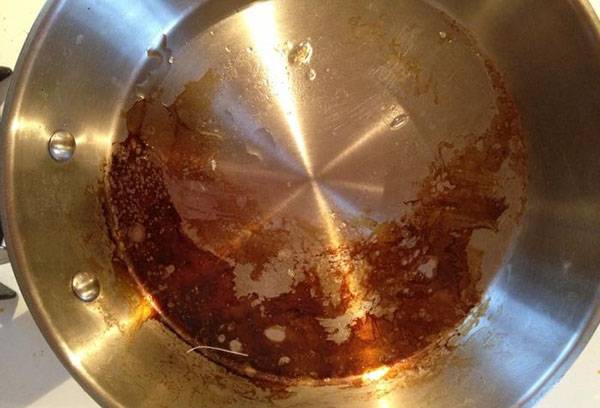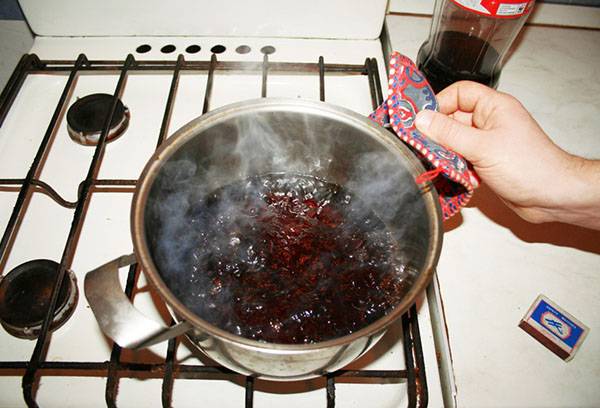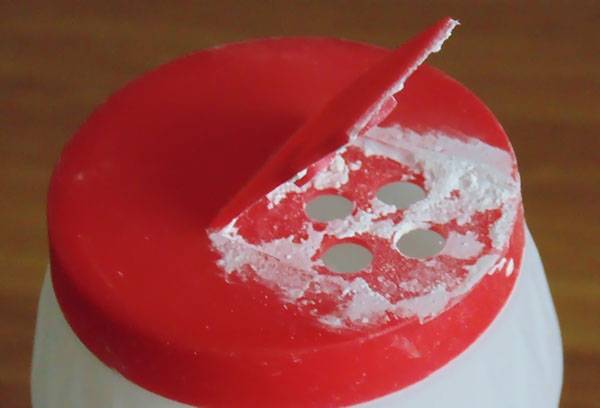The most effective ways to clean a bowl or pan of burnt jam
Content:
We all know how it happens: put a saucepan on the stove, surfed the Internet ... Fathers, but the water has already completely boiled away! And okay, if there were potatoes or eggs in the pan, but what if you have to clear the burnt jam? And if it also leaked onto the stove, then we sympathize with you in twins. And it is not easy to clean dishes and appliances from a layer of burnt sugar, but do not throw them away! So be patient and try to use the following tricks to simplify your task.
The very first and easiest step
Below in the article you will find more creative ways to clean the bottom of the pan, which can surprise you with the selection of funds and the way they are used. But for now, we advise you to start with the simplest thing: fill the pan with water. Of course, when jam on a bottom burnt in a thick layer resembles oil or tar rather in color, then this step will not be enough, but 6-8 hours in water will already do their job to remove a thin burn. In the end, it’s sugar, and if you keep the candy in water for a long time, then it will dissolve sooner or later.
If 6 hours to save the pan is an impermissible luxury, you can use several methods to improve and strengthen the power of the method.
- Any type of cookware will help clean the salt. Its mild or moderate solution can be used both for pots made of stainless steel or aluminum, and for enameled dishes. Just keep in mind that soaking the stick will still be 3-4 hours.
- The use of citric acid will be even more effective. Under its influence, the burnt jam softens faster and begins to move away from the bottom and the walls of the dishes.
- You can also use a solution of vinegar, because this substance is famous for a wide range of applications when it comes to cleaning and removing various types of dirt.
Tip
If you just fill the pan with water at room temperature with the addition of these products, then there is no point in worrying that you can ruin the dishes. Until you heat the water and use abrasive detergents, there is nothing to fear.
After a few hours, the burnt jam will get wet, and you can easily clean it with powders for cleaning, metal, but better - just an ordinary sponge.
If there is still heat
One of the most effective schemes is to “boil” the burn, pour boiling water over it or boil it on the stove for some time. The softening process in this case is faster, only if it is quite safe for an aluminum saucepan or stainless steel basin, enameled dishes can react to a sharp temperature drop with cracks in the enamel and its quick spoilage. That is why it is advised to heat the enameled glass gradually by pouring warm water and bringing it to a boil on the stove.
Can this process be strengthened? Quite! A solution of salt, soda or citric acid instead of plain water will allow you to clear the burnt jam from the pan a little faster. Just keep in mind that aluminum can become dark stained with soda, and long contact with salt also harms this type of cookware. For stainless steel and enamel, some even prepare an explosive mixture of soda, salt and citric acid: so a burnt jam at the bottom of the pan will certainly have no chance!
By the way
Sometimes when digesting carbon deposits on a stove at home, add a bulb, cut in half, to the water. They say that the effect is sometimes even better than from the use of special tools.
But as for the heating of vinegar - this is a moot point. Many people boil white vinegar in vinegar or try to clean metal utensils with a boiling solution, but we want to remind you that when heated, vinegar begins to release harmful substances into the air, which can affect your well-being. Be careful, and by choosing boiling with a solution of vinegar, at least ventilate the room well and do not stay in it for 10-20 minutes until the burn is cooked.
But what about special powder products?
In fact, with a very burned jam, purchased powder products will not help you: without soaking or digesting the soot, you will spend a lot of time and physical effort, and the result is still unlikely to please you.
But if you previously at least slightly softened the soot, then you can clean it with at least a special powder, at least with a metal sponge, even with ordinary salt or soda.
But think in advance about the integrity of the dishes.
- An enameled pan can not tolerate the effects of abrasive particles, and when cooking harmful metals through deep scratches will enter the food. But it is precisely from this that enamel is called upon to protect!
- If the protective layer of aluminum utensils is damaged during its further use, the metal will also penetrate into the food, although if you use an old aluminum basin, then, most likely, there is no protective coating on it for a long time. It all depends on the degree of your health concern.
- Pots and pots made of stainless steel are quite resistant to such mechanical cleaning. An abrasive can only slightly harm the mirror shine, but otherwise it will only help you quickly clean the dishes.
Tip
If you made jam in a slow cooker and did not calculate the mode, keep in mind that most of the containers of this technique have a non-stick coating, and in no case try to clean the bowl with a metal sponge or, even worse, scrape off the soot with a knife. The jam itself will lag behind if you fill the bowl with water and the protective coating will not be damaged.
More sophisticated burn-out methods
It is not known how they even thought of this before, but they also recommend cleaning pots with exotic substances such as silicate glue or bleach! We warn you in advance: they are hardly much more effective than the methods that we have already talked about, but if you have a craving for experiments, you can give them a chance.
- A strong burn is recommended to be removed by “boiling” burnt jam in water with the addition of 2-3 tablespoons of soda and a small amount of silicate glue.
- You can also rub the bottom and walls of the dishes with a mixture of shavings of laundry soap and PVA glue and leave for several hours for exposure.
- If you have cleaned the soot, but don’t want to wipe off the dark traces of it, some housewives recommend boiling a pot or bowl with White solution, but we, as in the case of vinegar, do not recommend this because of the harmful fumes that fill the air .
Tip
The faster you get rid of the burn, the less effort and time it will take. If you let the crust dry completely and harden, then you will have to “digest” the soot on the stove more than once, and you will need to soak the pan for days!
We are sure that it’s quite possible to clear your favorite pan of burnt jam, and now you have all the effective ways to deal with such deposits in your arsenal.



